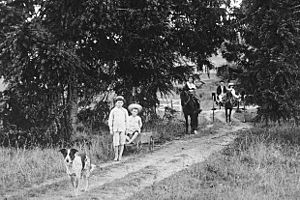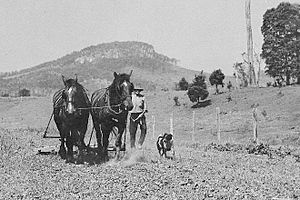Halls Heeler facts for kids

Halls Heeler, ca. 1902
|
|
| Breed status | Extinct |
|---|---|
| Domestic dog (Canis lupus familiaris) | |
The Halls Heeler was a special type of dog bred a long time ago in New South Wales, Australia. It was created by a man named Thomas Simpson Hall to help herd cattle on his family's huge farms. These dogs were super helpful for moving thousands of cattle across vast distances. The Halls Heeler is now extinct, but it's the ancestor of two popular dog breeds we know today: the Australian Cattle Dog and the Australian Stumpy Tail Cattle Dog. Sometimes its name is spelled Hall's Heeler.
Contents
A Dog for Australian Cattle
The Hall family came to the New South Wales Colony in 1802. By 1825, Thomas Simpson Hall and his brothers had started two cattle farms. These were Gundebri near Merriwa and Dartbrook near Aberdeen. Thomas Hall was only 20 years old in 1828 and managed Dartbrook.
From Dartbrook, Thomas Hall expanded his family's farms north. They eventually controlled over 1 million acres of good land for grazing cattle.
Breeding the Perfect Herding Dog
Thomas Hall needed a special dog to help move his cattle. He had thousands of cattle that needed to travel thousands of kilometers. These journeys were along unfenced stock routes through rough bush and mountains. Thomas was very frustrated when he lost 200 cattle in thick bush.
The working dogs available then were like Old English Sheepdogs. They were only good for short distances or for working with calm cattle in yards. Thomas Hall needed a dog that could handle wild cattle over long distances.
So, Thomas Hall imported dogs from Northumberland, England. These dogs were known as Northumberland Blue Merle Drovers Dogs. They were excellent at herding.
Thomas Hall then did something very clever. He crossed his imported Drovers Dogs with dingoes that he had tamed. He kept breeding the best dogs until 1840. By then, he had created the perfect working cattle dog for his needs.
The Halls Heeler's Secret Advantage
For the next 30 years, only the Hall family and their workers used Halls Heelers. These dogs gave them a big advantage over other cattle breeders. Because of this, the dogs were not shared outside the Hall family's properties.
After Thomas Hall died in 1870, his properties and cattle were sold. This is when Halls Heelers became available to everyone.
One drover named Jack Timmins worked for the Hall family. In the late 1840s, he got a pair of Halls Heelers. He bred his own line of these dogs. They were known as "great biters" and were called Timmins Biters. Another expert, Robert Kaleski, called them "wonderful workers" in 1911.
In 1976, a monument was built to honor Thomas Hall's achievement. It's on Dartbrook Road at the Blue Heeler Bridge. The plaque says that Thomas S. Hall created the Halls Heeler in 1840. It explains that these dogs became the foundation of today's Australian Cattle Dog.
What Halls Heelers Looked Like
Dogs were not usually bred to look exactly the same until the late 1800s. However, the Halls Heeler was described as looking like a strong, thick dingo. They usually had speckled blue or red fur.
Descendants of the Halls Heeler
By the 1890s, the Halls Heeler caught the eye of the Cattle Dog Club of Sydney. This group of men enjoyed showing dogs in competitions. They started using the name Australian Cattle Dog for dogs that came from Thomas Hall's "heelers." Breeders like the Bagust family were very important in developing these dogs.
Robert Kaleski, who was friends with Harry Bagust, noticed that breeders were trying to make the dogs look more consistent by 1893. So, he wrote down a standard for the breed.
Some Halls Heelers were born with short tails or no tails at all. Breeders started to selectively breed these dogs. This led to the development of the Australian Stumpy Tail Cattle Dog. This breed is now recognized by dog clubs in Australia and around the world.


